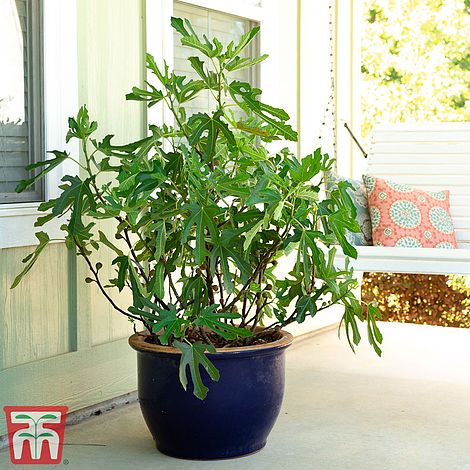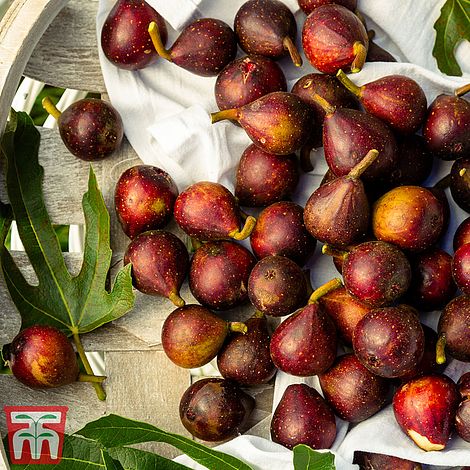It has been possible to grow figs in the U.K. for many years if you have a large enough garden and a south facing wall. Fig ‘Little Miss Figgy’ is new breeding that is particularly suitable for our often smaller gardens and allotments. Below are some of the reasons to grow this lovely plant:-
- This naturally small plant only grows to 1.8m (6ft) tall in it’s lifetime and a spread of 1.2m (4ft), making it very suitable for small gardens. It can be grown in the ground but is also ideal for a large patio container with it’s neat compact habit.
- It is a dwarf mutation of an older variety called ‘Violette de Bordeaux’ and, like it’s parent, will crop twice in a year in spring and early autumn.
- Like all fig varieties, it has wonderfully decorative lobed foliage for summer long interest.
- Will crop from the next year after planting on a fairly small plant.
- The fruits will ripen in our U.K. climate.
- The smooth skinned, sweet and juicy fruits that are full of goodness are available to pick from our own gardens when perfectly ripe.
- Food miles are much reduced by growing them yourself, rather than them travelling great distances to be delivered to the supermarkets.
- Fruits are borne in profusion along the branches.
As with all figs this plant will require a sheltered, sunny spot, ideally a south facing site against a wall. They prefer a moist but well drained, fertile soil that is slightly alkaline. If planting in the ground add well rotted manure or compost to the planting hole. Growth will be restricted if grown in a container, but if grown in the ground it is perhaps sensible to construct a 60cm (2ft) square open bottomed brick or concrete pit around the roots, adding a 15cm (6in) layer of broken stone to the base. A spring mulch is recommended. If grown in containers use a well drained, soil based compost such as John Innes No.3 and repot every couple of years. If training against a wall you will need to add support wires. Water regualrly in the hotter months.
In particularly cold areas the plants may need moving into a frost free area in the winter months, however in milder areas they can be protected by wrapping the plant in straw and hessian in severe weather. In our climate fruits will develop in spring, ripen through the summer and be ready to harvest in late summer/autumn when soft. A second crop may develop in late summer that should be left on the plant through winter to ripen the following year. It is these fruits and the stems that may require winter protection.
Some pruning will be required. Thompson & Morgan recommend the following:-
Figs may be fan trained against a wall or grown as a bush. To bush train: Start pruning fig trees in the first spring after planting. Select 8 to 10 well spaced branches on a clear trunk of at least 60cm (24″) and shorten them by half to encourage more branching and to establish a framework. Remove the central stem to just above the highest of the selected branches. Remove any crossing, crowded or damaged shoots from between selected branches to create an open bush.
In following years figs require little pruning except to remove any damaged or misplaced shoots to maintain the open framework. New shoots can be pinch pruned in summer back to 5 or 6 leaves to encourage fruit formation.
To view this plant at Thompson & Morgan click here
I hope that some of you will treat yourself to this wonderful plant and enjoy a delicious crop next year.
Mark Snelling
Caution: The foliage and sap of Ficus carica is harmful if eaten and may irritate the skin and eyes.
Images copyright Thompson & Morgan
If you have enjoyed reading our blog post then why not fill in the form provided to allow us to send you our blog posts and newsletters by email.


